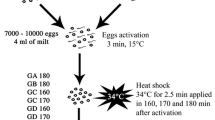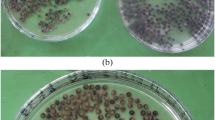Summary
In Xenopus laevis, which does not show sex chromosomal dimorphism, the female is heterogametic (WZ) and the male is homogametic (ZZ). By activating eggs with UV-irradiated spermatozoa, and by inhibiting the formation of the second polar body gynogenetic diploids were obtained, including some WW females. These super-females are fertile and not sublethal; by gynogenetic reproduction they in turn generate only WW females, while after mating with a male they give rise to WZ females exclusively.
From the sex ratio of the gynogenetic progeny of normal WZ females, the map distance between the centromere and the sex determining gene(s) has been calculated. By examining the sex ratio and the distribution of individuals exhibiting the phenotype of periodic albinism in the gynogenetic offspring of ap/+females, it has been demonstrated that the ap gene and the sex determining gene(s) are not linked.
Similar content being viewed by others
References
Barratt RW, Newmeyer D, Perkins DD, Garnjobst L (1954) Map construction in Neurospora crassa. Adv Genet 6:1–93
Blackler AW (1965) Germ-cell transfer and sex ratio in Xenopus laevis. J Embryol Exp Morphol 13:51–61
Chang CY, Witschi E (1955) Breeding of sex-reversed males of Xenopus laevis Daudin. Proc Soc Exp Biol, NY 89:150–152
Chang CY, Witschi E (1956) Genic control and hormonal reversal of sex differentiation in Xenopus. Proc Soc Exp Biol, NY 93:140–144
Droin A, Colombelli B (1982) “Bloated-1” and “bloated-2”, two recessive mutations in Xenopus borealis and Xenopus muelleri. Acta Embryol Morphol Exp 3:117–126
Gallien L (1955) Descendence unisexuée d'une femelle de Xenopus laevis Daud ayant subi, pendant sa vie larvaire, l'action gynogène du benzoate d'oestradiol. CR Acad Sci, Paris 240:913–915
Gallien L (1956) Invertion expérimentale du sexe chez un anoure inférieur, Xenopus laevis Daudin. Analyse des conséquences génétiques. Bull Biol France et Belgique 90:163–181
Gurdon JB (1967) African clawed toads. In: Wilt NH, Wessels NK (eds) Methods in developmental biology. Crowell Company, New York, pp 75–84
Hoperskaya OA (1975) The development of animals homozygous for a mutation causing periodic albinism (ap) in Xenopus laevis. J Embryol Exp Morphol 34:253–264
Humphrey RR (1945) Sex determination in ambystomid salamanders, a study of the progeny of females experimentally converted into males. Am J Anat 76:33–66
Krotoski DM, Tompkins R (1979) A new lethal mutation in the larvae of Xenopus laevis. Am Zool 19:951 (Abstr)
Mikamo K, Witschi E (1963) Functional sex-reversal in genetic females of Xenopus laevis, induced by implanted testes. Genetics 48:1411–1421
Mikamo K, Witschi E (1964) Masculinization and breeding of the WW Xenopus. Experientia 20:622–623
Mikamo K, Witschi E (1966) The mitotic chromosomes in Xenopus laevis (Daudin): normal, sex-reversed and females WW. Cytogenetics 5:1–19
Müller WP, Thiébaud ChH, Ricard L, Fischberg M (1978) The induction of triploidy by pressure in Xenopus laevis. Rev Suisse Zool 85:20–26
Nace GW, Richards CM, Asher JH (1970) Parthenogenesis and genetic variability. I. Linkage and inbreeding estimations in the frog, Rana pipiens. Genetics 66:349–368
Thiébaud ChH, Colombelli B, Müller WP (1984) Gynogenesis in Xenopus laevis and the localization of the gene for periodic albinism ap, submitted
Tymowska J (1977) A comparative study of the karyotypes of eight Xenopus species and subspecies which possess a 36-chromosome complement. Cytogenet Cell Genet 18:165–181
Tymowska J, Fischberg M (1973) Chromosome complements of the genus Xenopus. Chromosoma 44:335–342
Tymowska J, Kobel HR (1972) Karyotype analysis of Xenopus muelleri (Peters) and Xenopus laevis (Daudin), Pipidae. Cytogenetics 11:270–278
Author information
Authors and Affiliations
Additional information
Communicated by M.M. Green
Rights and permissions
About this article
Cite this article
Colombelli, B., Thiébaud, C.H. & Müller, W.P. Production of WW super females by diploid gynogenesis in Xenopus laevis . Molec. Gen. Genet. 194, 57–59 (1984). https://doi.org/10.1007/BF00383497
Received:
Issue Date:
DOI: https://doi.org/10.1007/BF00383497




